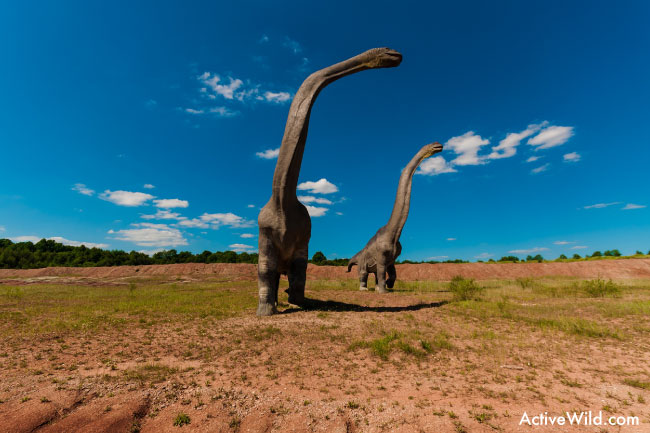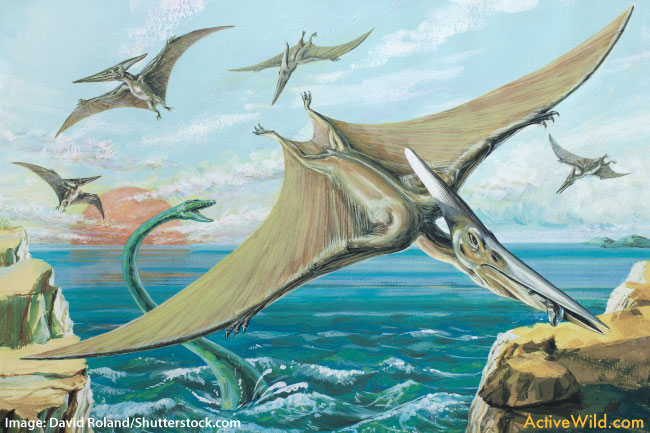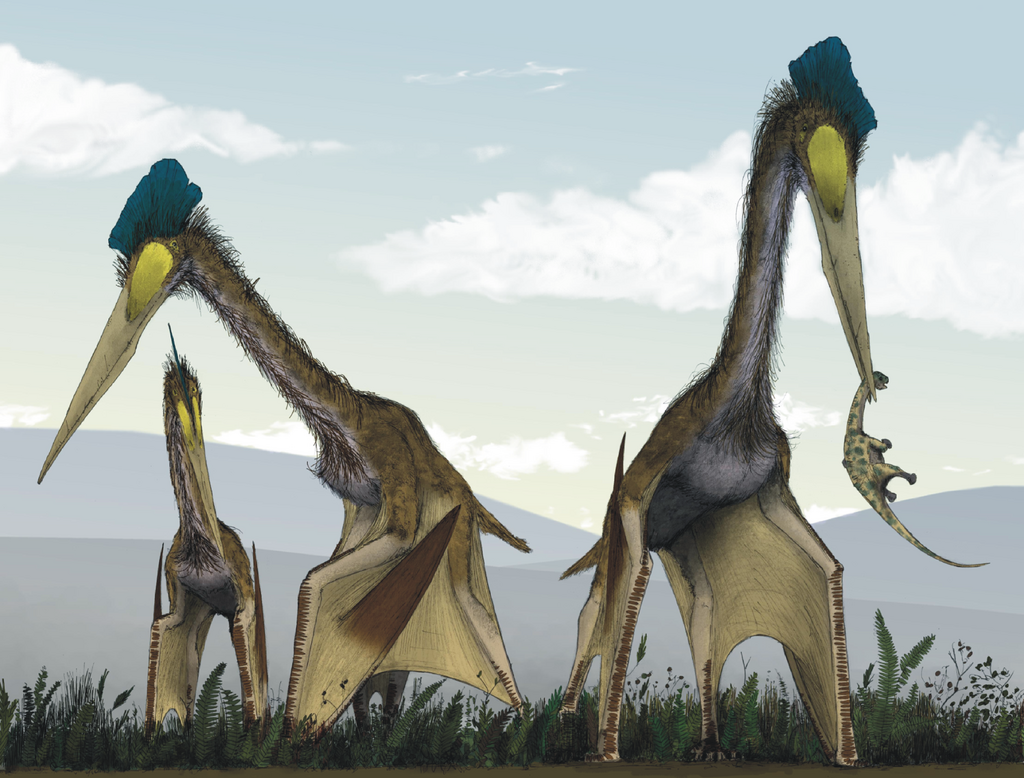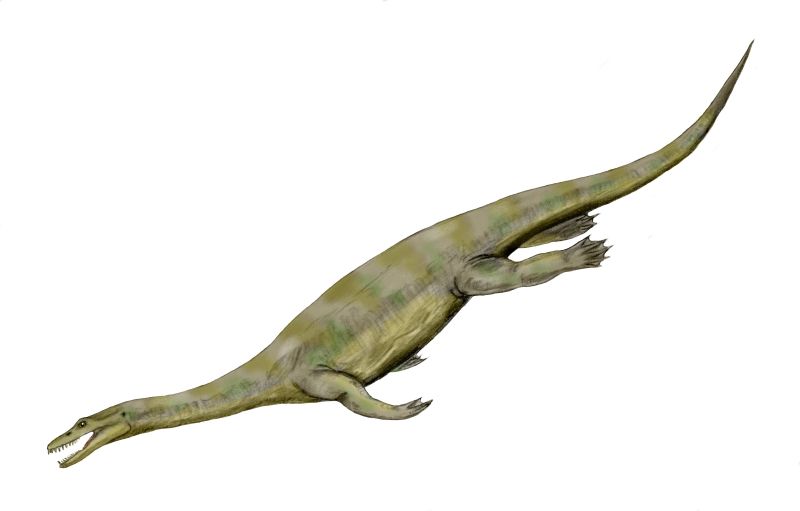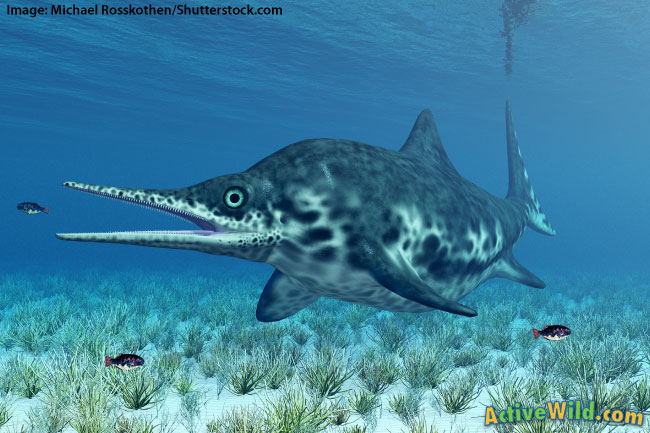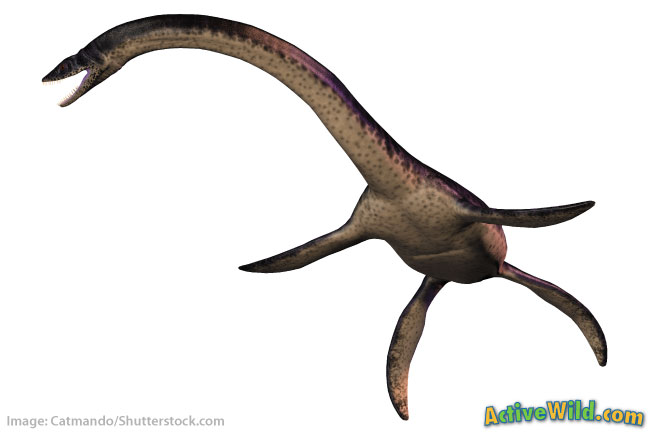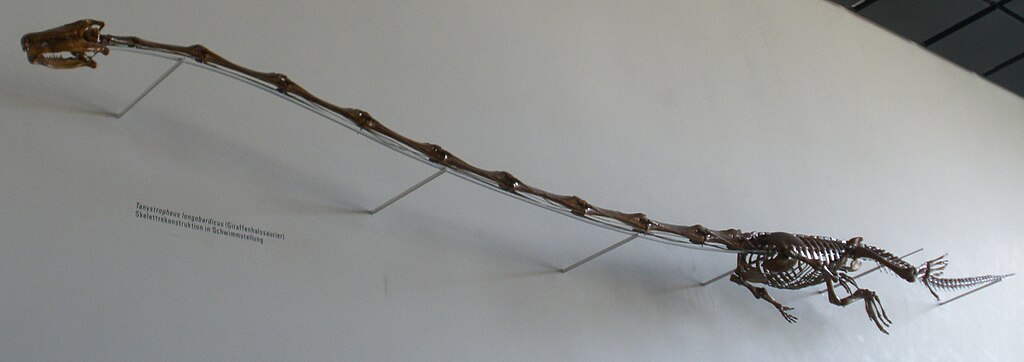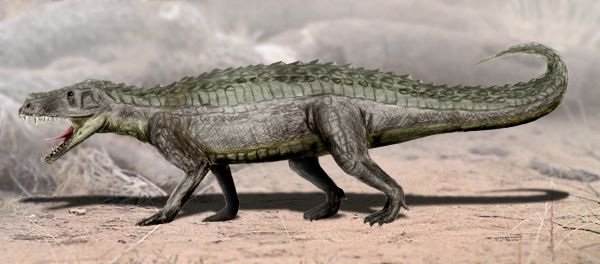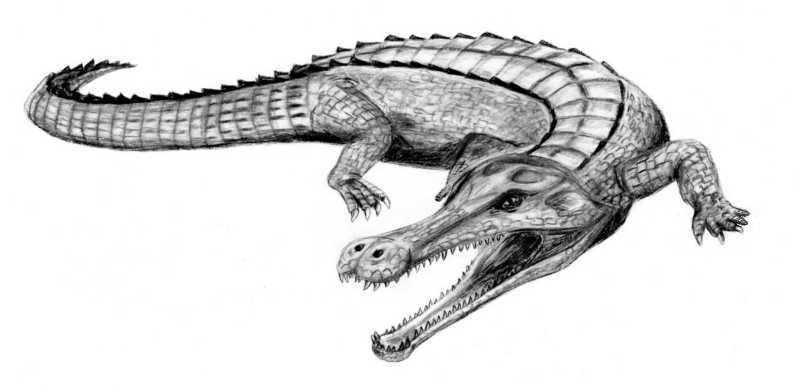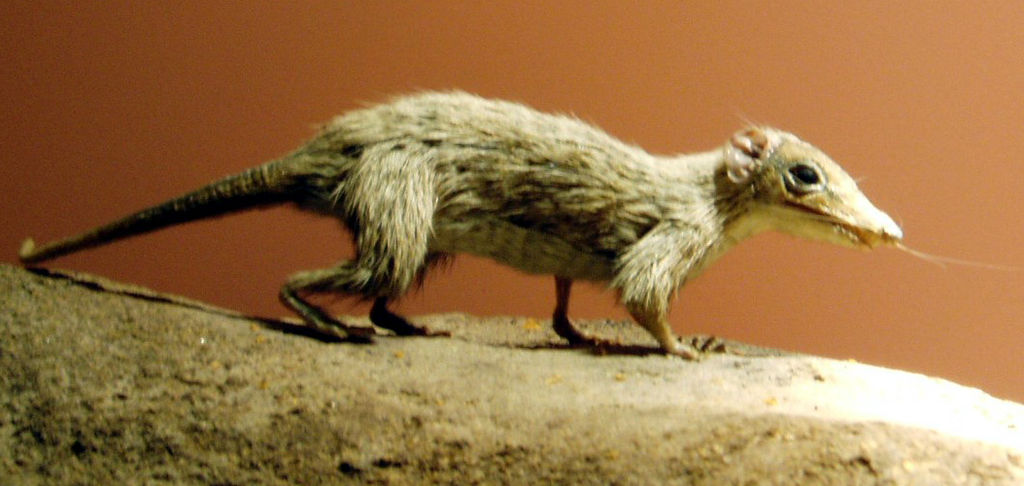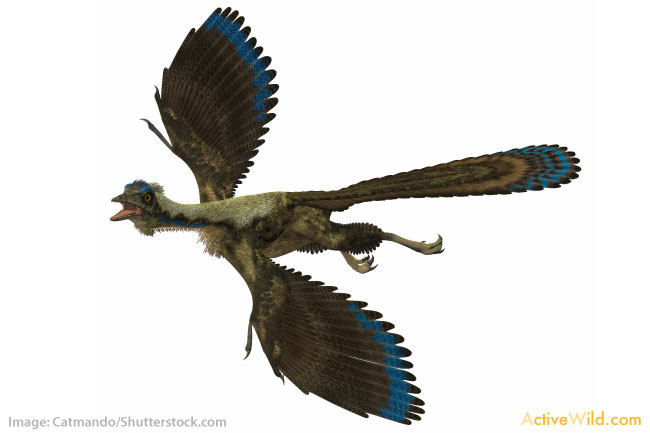We all know who the real ‘stars’ of the Mesozoic Era were, but there were plenty of other incredible animals that lived at the same time as dinosaurs.
On this page you'll find a list of animals that lived with dinosaurs, with pictures and information about many different types of Mesozoic species.
We’ve tried to include not only animals you’ve probably already heard of, but also a selection of lesser-known creatures of the Triassic, Jurassic and Cretaceous periods.
- This page is part of our Dinosaur Facts series.
Active Wild would like to thank Rupert Harwood for his invaluable help in compiling this article.
You’ll become a 'Mesozoic animal expert' if you read the whole page, but if you want to jump to a particular section you can use the links below:
- Flying Animals That Lived With Dinosaurs
- Sea Animals That Lived at the Same Time as Dinosaurs
- Other Reptiles That Lived With Dinosaurs on Land
- Early Crocodiles That Lived At The Same Time As Dinosaurs
- Mammals That Lived At The Same Time As Dinosaurs
- Other Animals That Lived With Dinosaurs
- Birds That Lived at the Same Time as Dinosaurs
Animals That Lived At The Same Time As Dinosaurs: Introduction
Because we hear so much about dinosaurs, it’s easy to forget that many other amazing animals lived in the Mesozoic Era.
Dinosaurs may have been the dominant animals on land, but in the sea and in the air it was a different story.
Swimming in the Mesozoic oceans were huge meat-eating reptiles such as Ichthyosaurs, Plesiosaurs and Mosasaurs, each of which were every bit as fearsome as their land-based cousins.
While dinosaurs were busy stomping around on the ground, huge flying reptiles called Pterosaurs were soaring above their heads. Although dinosaurs did eventually evolve into birds and 'learn to fly' it was the Pterosaurs who ruled the Mesozoic skies.
Even on land, dinosaurs needed to be careful when walking near rivers and lakes. Early crocodile-like animals appeared long before the dinosaurs. By the end of the Mesozoic Era, they had evolved into animals that weren’t really all that different to the crocodiles that live today – although some were much, much bigger!
Throughout the Mesozoic Era, the air would have been filled with the constant buzz of insects. Insects began to appear on Earth around 400 million years ago, in the Devonian period. That’s over 150 million years before the first dinosaurs!
Other familiar animals that lived in the Mesozoic Era include mammals, fish (including sharks), turtles, snakes, amphibians, lizards and birds. Some of these arrived before the dinosaurs, others after, but all were at some point alive at the same time as dinosaurs.
We'll find out about many of these further down the page, but first here's a reminder of how long ago all of this happened ...
When Did Dinosaurs Live?
The Mesozoic Era began around 252 million years ago, and lasted for around 186 million years. This immense period of time is divided into the Triassic, Jurassic and Cretaceous periods.
- You can find out more about the periods of the Mesozoic Era here: Dinosaur Periods.
Dinosaurs began to appear between 243 and 231 million years ago, during the mid to late Triassic period. They became the dominant land animals in the Jurassic period, and their reign continued throughout the Cretaceous period.
A worldwide extinction event that occurred around 66 million years ago* finally brought the reign of the dinosaurs to an end.
* For many years it was thought that the Cretaceous–Paleogene extinction event that wiped out the dinosaurs occurred around 65 million years ago. Subsequent studies by geologists have shifted the time back a million years.
- You can find out more about the extinction of the dinosaurs here: Why did Dinosaurs Become Extinct?
Although the Mesozoic Era is best known as the ‘Age of the Dinosaurs’, they weren’t the only animals around during this time. Let’s meet some of the animals that lived alongside the dinosaurs …
List Of Animals That Lived At The Same Time As Dinosaurs
Flying Animals That Lived With Dinosaurs
Pterosaurs – the ‘Flying Dinosaurs’
Despite often being called ‘flying dinosaurs’ Pterosaurs were NOT dinosaurs. Neither were they birds – or even ancestors of birds. They evolved quite independently to birds (which actually DID evolve from dinosaurs).
Pterosaurs appeared during the late Triassic period and existed right up to the end of the Cretaceous period. They had large, leathery wings, which were extended on specially-modified fourth fingers. Their other fingers formed claws which stuck out mid-way along their wings.
Dimorphodon
Dimorphodon was a pterosaur that lived in the early Jurassic period. Like other early pterosaurs, it had a long bony tail that ended with a flattened ‘paddle’. Its jaws were full of needle-like teeth.
Pterodactylus
Pterodactylus was a late Jurassic pterosaur. It didn’t have a tail, and was relatively small.
Pterodactylus was the first pterosaur to be identified as being a flying reptile. Because of this, the word ‘Pterodactyl’ is sometimes used to describe all pterosaurs.
- You can find out more about Pterodactylus here: Pterodactylus Facts.
Quetzalcoatlus
The Quetzalcoatlus, a late-cretaceous pterosaur, was the largest ever flying animal. Its wingspan may have reached 12 meters (39 ft.); that’s longer than 6 tall men lying head to toe!
Sea Animals That Lived With Dinosaurs
The ‘Swimming Dinosaurs’: Ichthyosaurs, Plesiosaurs And Mosasaurs
Throughout the Mesozoic Era, the world’s continents and oceans were continually changing shape and position.
In fact, at the beginning of the Mesozoic Era, there was only one huge continent, called Pangaea, and one ocean, called Panthalassa.
By the end of the Mesozoic Era, the continents were in roughly the positions that they are in today.
Throughout this time, various fearsome creatures fought for dominance of the seas.
Nothosaurs
Nothosaurs were a group of aquatic reptiles that spent much of their time in the water, but were able to haul themselves onto land to rest. Ranging from less than a meter (3ft.) to over 4 meters (13ft.), Nothosaurs had webbed feet and long necks.
Ichthyosaurs
Ichthyosaur means ‘fish lizard’. These large marine predators appeared in the early to mid Triassic period. They thrived throughout the late Triassic and early Jurassic periods.
Ichthyosaurs looked similar to today’s dolphins, and evolved from land animals in much the same way as dolphins did millions of years later.
When unrelated species evolve the same characteristics independently of one another in this way, it’s known as ‘convergent evolution’.
Plesiosaurs
Plesiosaurs were large marine reptiles with short tails and long necks (the necks of some plesiosaurs were over half the length of their entire bodies!). Plesiosaurs propelled themselves through the water with four large paddles using a ‘flying’ action.
Plesiosaurs appeared in the late Triassic period, and began to thrive during the Jurassic period, overtaking Ichthyosaurs as the dominant marine animals.
Pliosaurs
Pliosaurs were a group of large, short-necked Plesiosaurs. Pliosaurs such as Kronosaurus and Liopleurodon were some of the largest meat-eaters ever to have lived on Earth.
Mosasaurs
In the Cretaceous period plesiosaurs began to decline, and it was the Mosasaurs that took their place. Mosasaurs were fearsome-looking marine predators. They had large heads and jaws full of sharp teeth.
Other Reptiles That Lived With Dinosaurs on Land
Dinosaurs didn't have it all their own way! Both before and after the dinosaurs arrived, there were many other types of large predatory reptiles running around.
Proterosuchus
One of the largest land reptiles of the Early Triassic was Proterosuchus, a large, crocodile-like predator. Remains of this ambush hunter have been found in South Africa and China.
Tanystropheus
Tanystropheus was a 6 meter (20 ft.) long reptile that lived in the mid Triassic period. It was a strange-looking animal, whose neck was over twice its total body length. It probably hunted near water, plunging its long neck under the water to grab passing fish.
Archosaurs
Archosaurs were a group of reptiles that became the dominant land animals in the early Triassic period.
Euparkeria
A member of this group was Euparkeria, a crocodile-like animal that inhabited mid Triassic lakes, rivers and swamps. It may have been able to walk upright on its two longer hind legs, but is thought to have developed this ability independently of the dinosaurs.
Pseudosuchia
Archosaurs split into two main branches. One branch, the Avemetatarsalia, went on to become dinosaurs (and therefore birds) and also Pterosaurs.
The other branch was the Pseudosuchia. They were the ancestors of today’s Crocodilians – the group of animals that includes crocodiles, alligators and gharials.
These early crocodile-like animals dominated the land throughout the Triassic period, even after dinosaurs had appeared.
A mass extinction at the end of the Triassic period allowed the dinosaurs to take over from the Pseudosuchians at the start of the Jurassic period.
By the late Cretaceous period the Pseudosuchians had evolved into the Crocodilians ... and since then have changed very little.
An interesting fact that stems from all of this is that today, birds are the closest living relatives of the Crocodilians (and vice versa). Both of these groups are descended from Archosaurs! For example, a crow is more closely related to an alligator than a sea turtle!
Early Crocodiles That Lived At The Same Time As Dinosaurs
Postosuchus
Postosuchus was a Pseudosuchian that lived in the late Triassic period. It was one of the largest meat-eating reptiles of its day, and likely the apex predator in the North American region in which it lived.
Postosuchus grew to around 1.2 m (3.9 ft.) in height, and 4 m (13 ft.) in length. It had a huge skull, jaws filled with sharp teeth, and thick, armored skin.
Sarcosuchus
Sarcosuchus, whose name means ‘flesh crocodile’, was one of the largest crocodilians ever to have lived. It grew to around 12 m (39 ft) in length and weighed up to 8 tonnes (8.8 short tons).
Deinosuchus
Deinosuchus, whose name means ‘terrible crocodile’ was a large Crocodilian that lived in North America in the Late Cretaceous period. Although much bigger than modern day crocodilians, it was very similar in all other regards.
Turtles And Snakes
The crocodilians aren’t the only familiar reptiles that made it past the Cretaceous-Paleogene Extinction Event. The first lizards appeared in the Triassic period, and turtles and snakes appeared in the Cretaceous period; all are still around today.
Mammals That Lived At The Same Time As Dinosaurs
At some point In the Permian period, a new branch of reptile-like animals emerged. They were the Synapsids. Although many of these looked like lizards or small dinosaurs, one branch, called the Therapsids, would eventually evolve into mammals.
Therapsids were actually the dominant land animals in the Permian period, but in the Triassic the early Archosaurs took over. The mammals would have to wait their turn!
Let’s meet some notable mammals that were alive with the dinosaurs …
Thrinaxodon
Cynodonts were a group of Therapsids that were even more mammal-like than their predecessors. Thrinaxodon was a dog-sized cynodont that lived in South Africa in the Triassic period.
Although Thrinaxodon was still very reptilian, definite mammalian characteristics were beginning to emerge. It had specialised biting, chewing and cutting teeth, and may have had whiskers and fur – suggesting that it was warm-blooded.
Megazostrodon
Megazostrodon is considered by many to be one of the first mammals. It was a small, rat-like animal that appeared in the early Jurassic period. Although covered in fur, it still had a scaly tail. Megazostrodon had a larger brain that earlier Cynodonts, and was possibly nocturnal. Mothers may have produced milk for their young.
Didelphodon
Didelphodon was a cat-sized mammal that lived in North America during the Late Cretaceous period. It was a short but powerfully-built animal, likely to have been an aquatic predator.
Didelphodon didn’t make it past the Cretaceous-Paleogene Extinction Event, but luckily for us, some mammals did!
Other Animals That Lived With Dinosaurs
As we found at the beginning of this page, insects had been on Earth for millions of years before the dinosaurs. Huge dragonflies were buzzing back and forth through the air and beetles were scurrying across the ground long before the Mesozoic Era.
Flies appeared in the Triassic period, and more insects appeared as flowering plants evolved in the Jurassic period. The first moths and wasps appeared towards the end of the Jurassic period.
Amphibians, like insects, had been around since the Devonian period. Amphibians evolved from fish, and reptiles evolved from amphibians. Amphibians, therefore, represent the origin of all of the large land and water animals.
Beelzebufo ampinga
Beelzebufo ampinga, otherwise known as the ‘Devil Frog’ was a frog that lived in Madagascar in the Late Cretaceous period. It grew to over 40 cm (16 in.) in length, making it significantly larger than any living frog.
Birds That Lived at the Same Time as Dinosaurs
Birds evolved from a branch of dinosaurs called theropods, which also included well-known predators such as T Rex and Spinosaurus.
Archaeopteryx
Archaeopteryx was one of the earliest birds. It lived in what is now Europe in the Late Jurassic period. Although it still had reptilian characteristics such as teeth and a long, bony tail, it had feathers which were formed much like those of a modern bird.
Scientists are divided on whether Archaeopteryx was capable of full ‘flapping flight’ like a modern-day bird, or if it relied on gliding, with wing flaps to extend the time it was able to spend in the air.
- Read more about Archaeopteryx here: Archaeopteryx Facts
Iberomesornis
By the Early Cretaceous, the early birds were becoming even more bird-like, and less reptilian. Iberomesornis was a sparrow-sized animal that was fully-feathered and capable of flapping flight. From a distance it would have looked like a small, modern day songbird. Closer examination would have revealed that it still had claws on its wings and (probably) a beak full of teeth.
Animals That Lived With Dinosaurs: Conclusion
We hope that this page has given you some idea of the many different types of animal that lived alongside the dinosaurs.
Making a full list of animals that lived with dinosaurs is an impossible task: dinosaurs were present on Earth for millions of years, and during this vast period of time countless animals both appeared and became extinct.
Although dinosaurs are the most famous of the animals that were alive during the Mesozoic Era, there was a multitude of other types of animals living at the same time.
While some of these, such as the pterosaurs and plesiosaurs, were ‘dinosaur-like’ in appearance, others looked more like animals that are still around today. We hope that you've enjoyed meeting some of the non-dinosaur animals of the Mesozoic era!
Now that you know all about the animals that lived at the same time as dinosaurs, check out some other dinosaur pages:
- Become a dinosaur expert: read our main Dinosaur Facts page!
- Discover some amazing dinos here: List of Dinosaurs
- Want to learn about more prehistoric animals? Visit: List Of Prehistoric Animals That Are Not Dinosaurs



